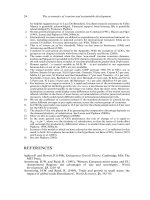THE ECONOMICS OF MONEY,BANKING, AND FINANCIAL MARKETS 374
Bạn đang xem bản rút gọn của tài liệu. Xem và tải ngay bản đầy đủ của tài liệu tại đây (54.18 KB, 1 trang )
342
PA R T I V
GLOBAL
The Management of Financial Institutions
Barings, Daiwa, Sumitomo, and Soci t G n rale:
Rogue Traders and the Principal Agent Problem
The demise of Barings, a venerable British
bank over a century old, is a sad morality tale
of how the principal agent problem operating through a rogue trader can take a financial institution that has a healthy balance
sheet one month and turn it into an insolvent
tragedy the next.
In July 1992, Nick Leeson, Barings s new
head clerk at its Singapore branch, began to
speculate on the Nikkei, the Japanese version
of the Dow Jones index. By late 1992, Leeson
had suffered losses of US$3 million, which he
hid from his superiors by stashing the losses in
a secret account. He even fooled his superiors
into thinking he was generating large profits,
thanks to a failure of internal controls at his
firm that allowed him to execute trades on the
Singapore exchange and oversee the bookkeeping of those trades. (As anyone who runs
a cash business, such as a bar, knows, there is
always a lower likelihood of fraud if more than
one person handles the cash. Similarly for trading operations, you never mix management of
the back room with management of the front
room; this principle was grossly violated by
Barings management.)
Things didn t get better for Leeson, who by
late 1994 had losses exceeding US$250 million.
In January and February 1995, he bet the bank.
On January 17, 1995, the day of the earthquake in Kobe, Japan, he lost US$75 million,
and by the end of the week had lost more than
US$150 million. When the stock market
declined on February 23, leaving him with a
further loss of US$250 million, he called it quits
and fled Singapore. Three days later, he turned
himself in at the Frankfurt airport. By the end
of his wild ride, Leeson s losses, US$1.3 billion
in all, ate up Barings s capital and caused the
bank to fail. Leeson was subsequently convicted and sent to jail in Singapore for his activities. He was released in 1999 and apologized
for his actions.
Our asymmetric information analysis of the
principal agent problem explains Leeson s
behaviour and the danger of Barings s management lapse. By letting Leeson control both
his own trades and the back room, it increased
asymmetric information because it reduced
the principal s (Barings s) knowledge about
Leeson s trading activities. This lapse increased
the moral hazard incentive for him to take risks
at the bank s expense, as he was now less
likely to be caught. Furthermore, once he had
experienced large losses, he had even greater
incentives to take on even higher risk because
if his bets worked out, he could reverse his
losses and keep in good standing with the
company, whereas if his bets soured, he had
little to lose since he was out of a job anyway.
Indeed, the bigger his losses, the more he had
to gain by placing bigger bets, which explains
the escalation of the amount of his trades as
his losses mounted. If Barings s managers had
understood the principal agent problem, they
would have been more vigilant at finding out
what Leeson was up to, and the bank might
still be here today.
Unfortunately, Nick Leeson is no longer a
rarity in the rogue traders billionaire club,
those who have lost more than US$1 billion.
Over 11 years, Toshihide Iguchi, an officer in
the New York branch of Daiwa Bank, also had
control of both the bond trading operation and the back room, and he racked up
US$1.1 billion in losses over the period. In July
1995, Iguchi disclosed his losses to his superiors, but the management of the bank did not
disclose them to its regulators. The result was
that Daiwa was slapped with a US$340 million
fine and the bank was thrown out of the country by U.S. bank regulators. Yasuo Hamanaka
is also a member of the billionaire club. In July
1996, he topped Leeson s and Iguchi s record,
losing US$2.6 billion for his employer, the
Sumitomo Corporation, one of Japan s top
trading companies. Jerome Kerriel s loss for his
bank, Soci t G n rale, in January 2008 set the
all-time record for a rogue trader: his unauthorized trades cost the bank US$7.2 billion.
The moral of these stories is that management of firms engaged in trading activities
must reduce the principal agent problem by
closely monitoring their traders activities, or
the rogues gallery will continue to grow.









